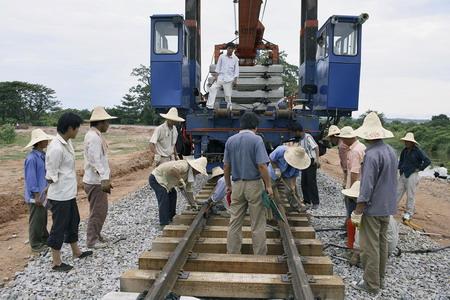
Chinese railway workers lay tracks in Dondo, about 200 kilometers outside Luanda, Angola. [Per-Anders Pettersson / Getty Images]
Nation builds key infrastructure, sends thousands of medical staffBEIJING - Wang Gang, a 35-year-old doctor from Shandong, never thought that he would one day carry out surgery for children in Liberia as the only pediatrician in the West African country.
Wang was one of the young Chinese doctors sent to Liberia last year as volunteers to provide medical assistance to one of the world's poorest countries.
"I was astonished to find that Liberia, a country with a population of about 3 million, only has 136 registered doctors in total and I was the only pediatrician there," Wang said.
In the past year, Wang has treated more than 1,200 patients and carried out 120 operations for local children. Due to shortages of materials and the poor medical conditions, Liberia is plagued by malaria, typhoid, AIDS and other infectious diseases and has a high infant mortality rate of 10 percent.
"I've always told myself that although my presence couldn't change everything overnight, at least I could treat and save every child that came to me," he said.
Although Wang has finished his mission in Liberia and returned home, more young doctors from China are following in Wang's footsteps, extending helping hands to patients in many developing countries around the world.
In the past decades, China has been rising on the world stage not only as a powerful economy but also as a donor in international aid and humanitarian efforts.

Since 1963, China has sent more than 20,000 medical staff to 65 countries and regions in Asia, Africa and Latin America. Currently, there are more than 48 medical teams, comprising 1,200 people, working in 47 countries, according to the Ministry of Commerce.
In addition to medical assistance, China bolstered its foreign aid effort through the financing of infrastructure and natural resource development projects, assistance in the implementation of projects and major investments in many developing countries.
In the field of infrastructure and public facilities, China has helped to build a number of railways, airports, bridges, schools and medical centers in more than 1,000 projects which have greatly improved local people's livelihoods and promoted economic development.
The Tanzania-Zambia Railway, which was completed in 1975, is one of the largest Chinese-funded overseas aid projects. It has been playing an important role in giving landlocked Zambia a link to the Tanzanian port of Dar es Salaam and promoting regional economic development since its completion.
Moreover, Chinese aid and investment has met development needs in countries that have been relatively neglected by Western aid donors.
According to the Ministry of Commerce, China has provided aid to more than 160 countries in Africa, Asia, Latin America and the South Pacific though nearly 2,000 aid projects including agriculture, construction, transportation, healthcare and education since 1950.
While grappling with its own poverty and other difficulties in its modernization process, China has been actively promoting cooperation in global development to achieve win-win results with its partners.
In order to encourage educational and cultural exchanges, the Chinese government funded 1,395 research and training programs over the past 11 years. These programs were attended by 36,364 government officials from developing countries, according to the Ministry of Education.
China has also strengthened its humanitarian aid to countries hit by major natural disasters by providing relief aid worth of 500 million yuan ($73.78 million) to 19 countries.





